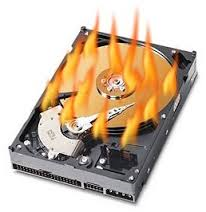
It is a sad fact that the only people who prick up their ears and actually listen when I start talking about data loss and its prevention are those who have previously experienced the loss of a hard drive. They KNOW the hassle involved and they really never want to go through it all again. Everyone else just thinks I must be exaggerating – “ it can’t be that bad”. Well, believe me, it can! The first reaction I get when I mention backups is either a blank stare because my listener doesn’t know what I’m even talking about, or, the more IT-aware among us, smile knowingly and say, with varying degrees of smugness, “ I’m OK, everything I care about is backed up every night !”. Unfortunately, MOST of the people falling into the latter category are just simply wrong!
The first mistake is to think that copying the critical files you know about is all you need to do. Let’s assume that you copy your photographs, all the contents of your ‘My Documents” folder, all your iTunes music files, and you remember to copy the work in progress files that you have stored ‘on the desktop’. Let’s also assume that, being business savvy, you’ve also backed up your Sage data and you have a separate copy of all your ‘sent out’ invoices. That’s not bad, is it? So then you have your disaster! IT disasters come in all shapes and sizes, but let’s just concentrate on the type that involves the loss of a hard drive. People say, “ hard disks don’t fail these days though, do they?” Well, yes, they do, and probably more frequently than most people think. It isn’t just mechanical or electrical / electronic failures that can cause a hard disk to cease to function. They are subject to various degrees of file corruption as a result of badly written software, poor operating procedures, malware (i.e. virus type software), deliberate or accidental file or folder deletion. Basically any piece of software is capable of scrambling up the ones and zeros on the disk surface and then you have an ‘unreadable’ disk. Of course, you could have your disk stolen (especially if it’s in a laptop) or it could go up in flames when your study burns down. In any event, let’s assume the disk is lost – irretrievably! The first indication you’ll often get is when you turn on your computer – nothing happens! Well, more precisely, you get a black screen with white writing which says, “Cannot find boot device” or some other gobbledegook message. So, what now?
Whether you call an IT professional or not we are assuming, remember, the disk is ‘lost’, so all he can do is provide a new ‘empty’ disk. You still have the ‘cannot find boot device’ message because the disk is no better than the one he replaced – i.e. it still has nothing on it. So, we start to rebuild it. First we need to install Windows. Windows is software which was originally installed by your computer manufacturer, so you’ve never had to install it before. You will need to find the recovery disks which were possibly in the original box along with the manual you never read. If you can’t find these disks, it’s possible you were expected to create them yourself, but you never got round to it, or didn’t even realise it was something you needed to do. Some PCs have a ‘recovery partition’ on the same hard disk that’s now lost, so that can’t be used. You will have to fork out and buy a copy of Windows. So, you’ve got your Windows CD and you figure out how to run the install process and you get Windows installed on your new disk. The computer now presents you with Microsoft’s ‘Out of Box Experience’. This enables you to enter your name and a password and invites you to connect to the Internet. Don’t even bother – at this stage it just won’t work. You now need to install ‘drivers’ which are small programs needed to control many of the features of your computer like sound, graphics, networking and some others. If you can download the drivers from the manufacturer’s website, (onto an internet connected working PC), transfer them and install them correctly, you will have a working copy of Windows and you should be able to get connected to the Internet. You may now think you can just copy back the personal and critical files you had previously backed up and you’ll be fine.
Unfortunately, you will realise at this point that you still have a long way to go. You don’t, at this stage have any programs installed. You need, Word, Excel, Outlook, Powerpoint, iTunes, printer drivers, camera software and every other piece of software you’ve ever installed since you bought the computer including AntiVirus software, DVD writing software and other things you didn’t even know you had. You will need CDs and serial numbers for all of this. Then you copy back your personal files. It is at this point you begin to realise how much you’ve lost. Outlook needs set up with your email account information. You do this and realise you never backed up your emails (every email from the last 5 years have gone from Inbox , Sent Mail and any other folders you previously had.) Your address book isn’t there either – nor is your calendar and your task lists. All your favourites and shortcuts are gone. And the list goes on and on. You realise after a few days that there was so much on your computer that just isn’t there anymore and that you will have to learn to live without. The next time someone like me starts talking about backups and data loss, your ears will prick up! You’ll be one of the few listening heads in the room. You’ve been there and you won’t want it to happen again

